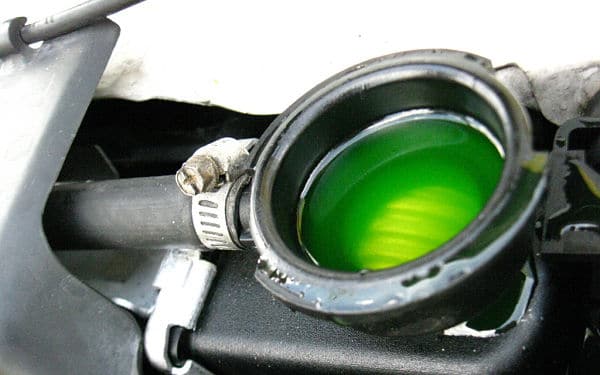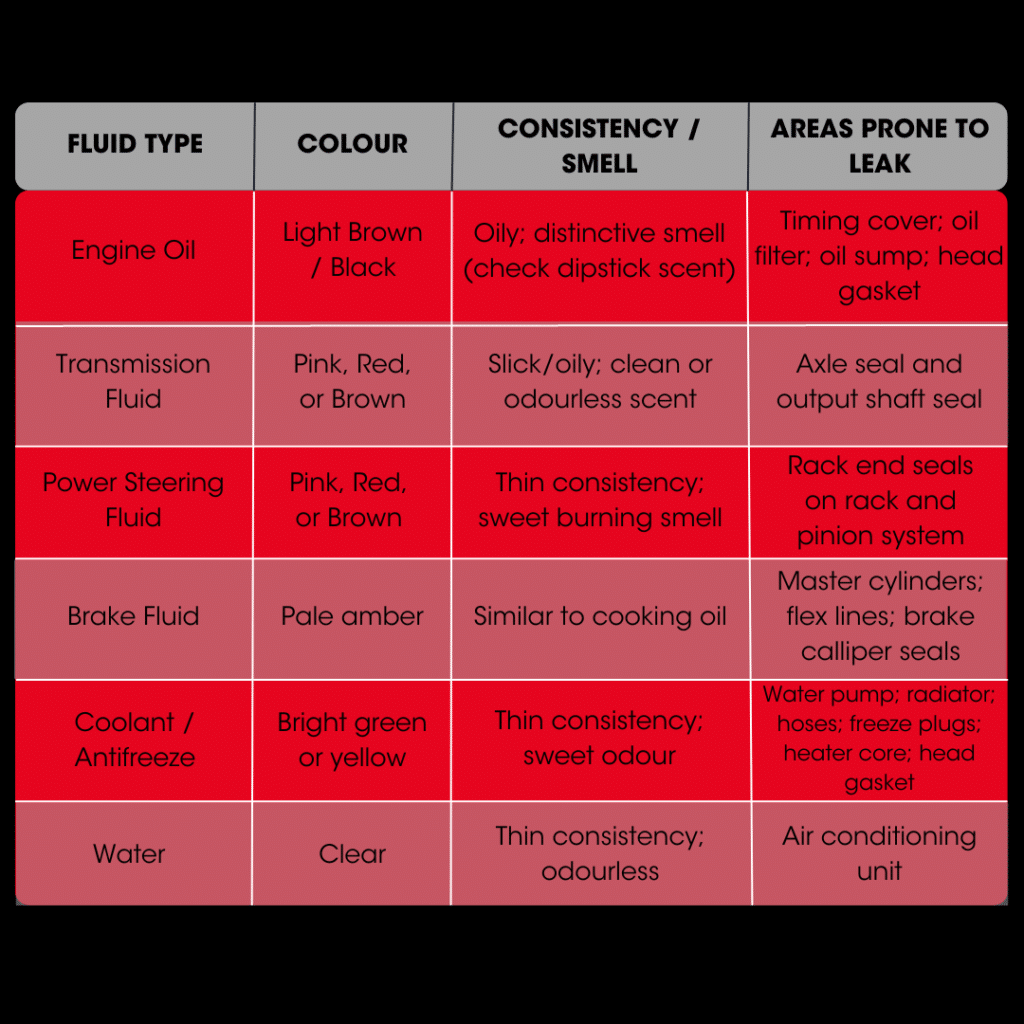Leaks are often the first sign of problems beneath the bonnet of your car. From steering and braking issues to overheating, loss of performance or complete engine failure, if a leak isn’t taken seriously, the consequences can be costly. Leaks are a problem all motorists will likely have to face at some point, so it’s important to know exactly what’s leaking and why.
To help you identify the fluid that’s leaking from your car, here’s a brief guide on how to recognise leaks beneath the bonnet or on your driveway. Our guide includes a quick reference table to the different characteristics of each fluid, as well as useful tips on the best way to spot if your car has a leak.
Quick links
- What’s that Leak? Quick Reference Guide
- How to Know if Your Car Has a Fluid Leak
- Engine Oil Leak
- Transmission Fluid Leak
- Power Steering Fluid Leak
- Brake Fluid Leak
- Coolant/Antifreeze Leak
- Water Leak
- Screenwash/Wiper Fluid Leak
What’s that Leak? Quick Reference Guide
Use the table below to quickly identify the fluid that’s leaking from your car, or scroll down for more information on the characteristics of each fluid, and where they’re likely to be leaking from.
How to Know if Your Car Has a Fluid Leak
It can be tricky to determine whether your car has sprung a leak, and locate where it’s coming from. Here, we offer practical tips on how to detect a leak before it can become a serious problem.
- Place cardboard or newspaper beneath your car — This is an easy way to check if your car has developed a leak, and identify the fluid by its colour, smell, consistency – helping you diagnose the problem early. Once you’ve placed the cardboard/paper, leave the car stationary for a good period (overnight if possible), giving the fluid time to drip.
- Look for fluid on components beneath the car — If you’re having trouble finding the source of a leak, jack the car up and have a look at the components on the undercarriage. If one of the mechanical areas is leaking, the fluid may blow backwards onto different components as you drive. Move forward from where you spot the sign of drips, and you should find the culprit.
- Use white foot powder to trace the source of a leak — Once you’ve found the general area of where a leak is coming from, using spray-on white foot powder is a good way to work out exactly which component is faulty. Foot powder is great because it easily wipes off, and will highlight what’s dripping and where from. Spray the powder onto the suspected area, then run the engine for a few seconds. If you’ve sprayed in the right place, you should find drips in the white powder – helping you trace the leak to its source.
- Park on a flat surface when checking for leaks — It might sound obvious, but always remember to park somewhere flat when checking for leaks. If the car is on a slope, it’ll make it much more difficult to trace any drips back to the problem area. Not only that, but it’ll skew the levels on the reservoirs beneath the bonnet, so you won’t be able to get an accurate reading.
Types of Vehicle Leaks in More Detail
Engine Oil Leak
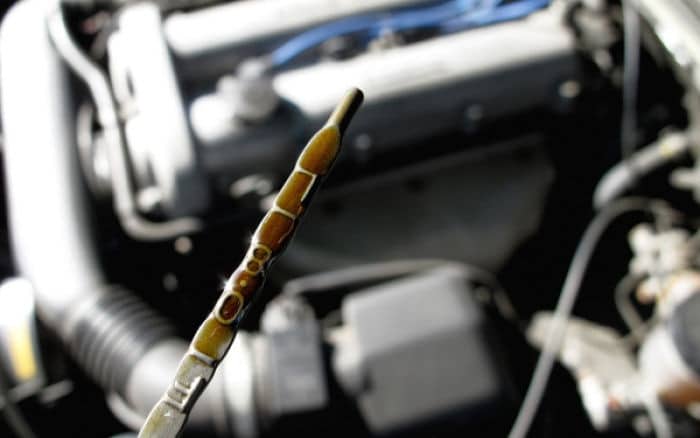
If your car is leaking black or brown liquid, it’s almost certainly oil.
The colour of engine oil depends on when it was last changed and the age of your car. New engine oil is light brown in colour but can look black if it hasn’t been changed in a while.
If your car is leaking engine oil, there could be a stain where you’ve been parked. Engine oil will feel oily to touch (obviously) and won’t be easily washed away with water. Each brand smells different, so if you’re unsure, remove the dipstick and check the odour of your engine oil.
Oil can often leak from the timing cover, oil filter, sump plug and head gasket. A small leak (a few drops every week) may be usual on high-mileage vehicles, so ensure you keep it topped up and check the levels regularly. Larger leaks should be fixed, so take your car to a professional mechanic if you suspect an engine oil leak.
The process of fixing an engine oil leak is obviously different depending on where the fault is, and its severity. In most cases, we’d recommend seeking a professional repair if oil is leaking from your car, as it’s likely that one or more components within the engine may need to be repaired or replaced.
Transmission Fluid Leak
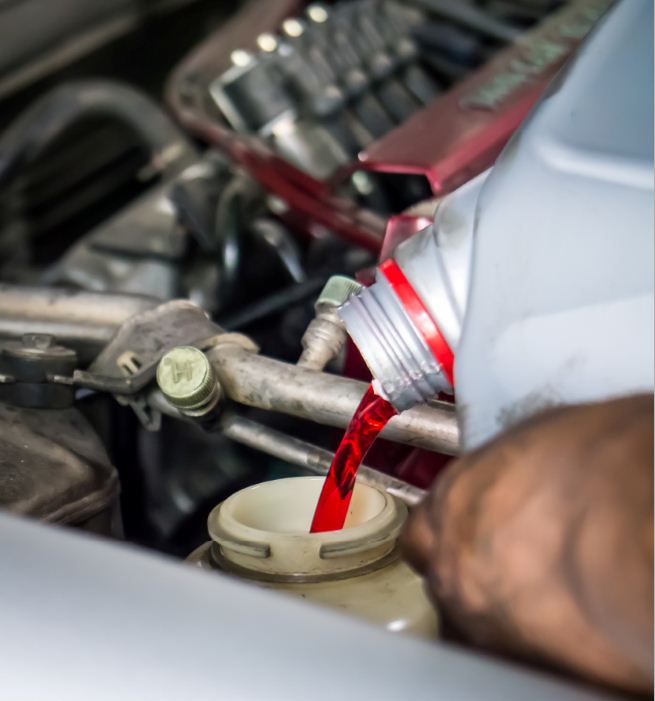
Leaks aren’t common on manual transmission cars but are more common in automatics. Common areas prone to transmission fluid leaks include the axle seal and output shaft seal. If you notice a significant leak, it’s always best to have a professional take a look.
If you suspect a transmission fluid leak, it’s important not to drive or even start your car. Transmission fluid is hydraulic and helps to drive the gearing system. If you start the engine when there’s a transmission fluid leak, you risk major damage to your car which may be very expensive – or even impossible – to repair.
Power Steering Fluid Leak
Not to be mistaken for transmission fluid; power steering fluid has a reddish-brown colouring and thin consistency. What sets it apart from transmission fluid is its distinctive smell, which is quite difficult to describe; we’d say it’s like something sweet burning.
Power steering fluid leaks are rare, but when they do occur it’s normally near the steering rack, specifically the rack end seals on a rack and pinion steering system. This may result in the system squealing or the steering becoming heavy. Top up the system following the manufacturer’s guidelines and monitor the levels. If the leak persists, have a professional take a look.
If your power steering is leaking, don’t be tempted to drive. It’s difficult to predict how the leak might affect how your car handles, so have a professional take a look before moving it again.
For more information and advice, read our in-depth guide to power steering fluid leaks.
Brake Fluid Leak
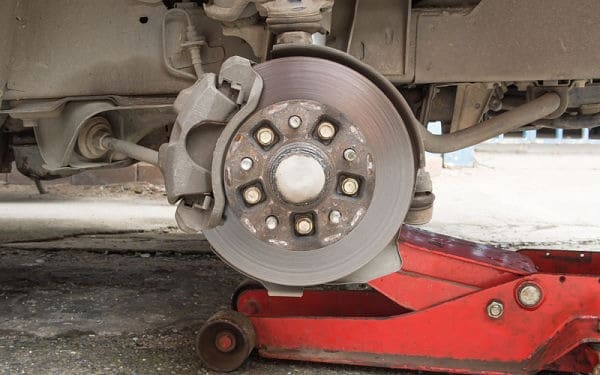
Brake fluid is characterised by its colour – in that it doesn’t have one relative to other fluids in the car. It’s clear or pale amber and resembles cooking oil. As for smell, many people say it has the odour of fish oil.
Areas prone to brake fluid leakage are the master cylinders and flex lines, as well as the brake calliper seals. If you suspect a brake fluid leak, don’t drive the car! Check the level and top it up if necessary. Start the car and pump the brakes while stationary, and check if the level has dropped. Have a professional check it out immediately if you suspect a leak.
Looking for more advice on this particular car fluid? Our comprehensive 101 guide to brake fluid answers more key questions, and provides advice on how to change and top up your car’s brake fluid.
Coolant/Antifreeze Leak
Of all the fluids to spring a leak beneath the bonnet, coolant/antifreeze is the easiest to identify.
This is thanks to its bright green or yellow colour, and its distinctive sweet odour.
There are many places around the engine bay where coolant/antifreeze can leak from, and any leaks are usually easy to find. Coolant/antifreeze leaks can occur on the water pump, radiator, hoses, freeze plugs, heater core and head gasket.
You might not need to pull over right away if your car has a coolant/antifreeze leak; it depends on the severity of the problem. Often, you’ll only notice a leak if your car’s engine temperature starts rising and you notice a warning light on the dashboard.
Coolant/antifreeze leaks happen for all sorts of reasons but are mainly due to general wear and tear – particularly around joints in the cooling system. A mechanic will be able to diagnose where your cooling system is leaking and advise whether or not it can be repaired without requiring a replacement part.
Learn more about what happens to your car when you have a coolant/antifreeze leak
Water Leak
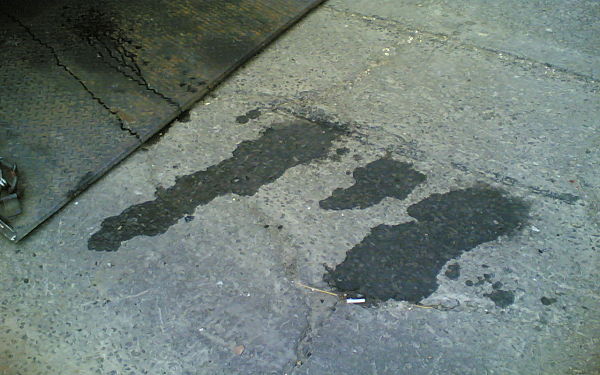
We won’t insult your intelligence by going into detail about how water looks, feels and smells.
Basically, if you notice clear, odourless liquid dripping from your car — particularly on the front passenger side — there’s no need to worry. If your car has air conditioning which was switched on before you parked, it may be that the condensed water has drained from the conditioning unit, leaving a small pool on your driveway.
That said, if you’re worried about why so much water is leaking from your car, it could be worth getting it checked by a mechanic. In rare cases, your car may have a fault whereby it gathers rainwater in certain panels, rather than sluicing it away. This is particularly common on sills beneath the doors, and if it’s not dealt with, it could cause premature rust or mould growth.
If in doubt, always have your car checked to put your mind at ease.
Screenwash/Wiper Fluid Leak
Did you recently fill up your washer bottle only to find that you’ve run out almost instantly? You could have a screenwash leak.
Screenwash is easily identifiable thanks to its soapy smell and bright colour. It’s important to rinse it away if you notice any on the ground, however, as it can be toxic to cats, dogs and other wildlife.
The good news is, if you have a screenwash leak, you know exactly where the problem is. There’s either a small hole or crack in the washer bottle; in the hose connecting it to the cap; or a fault with the seal on the screenwash filler cap itself.
Replacing one or all of the above components shouldn’t be too expensive depending on your car, but we would recommend having it done by a professional, as these parts can be tricky to access under the bonnet.
At Prestone we test our products in the toughest conditions, so you know they perform for you every day on the road. To find out more about our products, visit the Prestone website.
